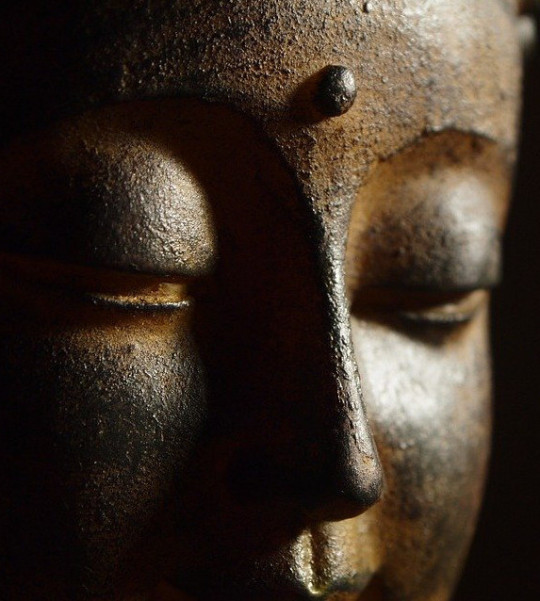#Buddhism and cosmology
Text
TRIPITAKA - the lost spiritual sequel to Cosmology of Kyoto was found

This post is a compilation of a series of tweets I have composed over a period of weeks during this summer.
For years, it was uncertain whether TRIPITAKA 玄奘三蔵求法の旅, by Soft Edge, had in fact ever been published. I remind the more absent-minded readers that this is the studio responsible for the mythical CD-ROM Cosmology of Kyoto, originally released in Japan in 1993, later published in the United States by Yano Electric in 1995. Knowledge of this their second and final production comes solely from the online CVs of producers Hiroshi Ōnishi and Mori Kōichi. No other information could be found online, and no actual copy of the game was known to exist.
Earlier this year, this disc surfaced at Yahoo Auctions. It sold for nearly $300 after 24 bids.

As suggested by its tile, which translates to Xuanzang Sanzo's Dharma-Seeking Journey, it was always assumed that the game illustrated episodes of the life of the celebrated Chinese Buddhist monk, particularly his 7th century pilgrimage to India. The captures printed on the back not only show a character highly reminiscent of the ancient scholar, they depict a variety of scenes taking place in China and India.
According to the severely incomplete archived version of PD Inc's website, the Japanese publisher responsible for this digipack, it was available for sale at museums hosting the 1999 Silk Road Journey To The West exhibition, which suitably matches the date printed on the back cover. However, this date presents yet another open question, as the Ōnishi-San and Kōichi-San bios both list it as a 1995 production.

The technical specifications may provide an enlightening clue, as they refer to Windows 95, 640x480px resolution and an 8-Bit color mode. This indicates that TRIPITAKA was indeed developed sometime between 1993 and 1995, although it was never published in the CD-ROM game circuit, certainly not in the immediate years after its development was completed. Combined with the data retrieved from the publisher's website, the edition shown here appears to have been produced solely for the occasion, as a means to diversify the museum shop catalog for this major exhibit, given the shared theme.
It would have been nearly impossible, had the program been in fact published in 1995, for a single copy to not have been spotted or mentioned online by the many Japanese collectors who have attempted to locate it for decades, unsuccessfully. On the other hand, a CD-ROM that was sold at a museum exhibit is likely to be purchased by visitors who were entirely unaware of the item's relevance as an elusive multimedia gem.
If a tangent is permitted here, both productions are inextricably linked with the museum space, and as far as I can speculate, Cosmology of Kyoto was, itself, also published with the intention of being made available in gallery stores in addition to computer game retailers. I say this because this was a production made possible by collaborative efforts including a variety of Japanese museums, to the extent these are referenced by name in the game's credits.
Considering the price at which the item was sold at auction, I was fairly certain that it was purchased by one such video game collector who knew exactly what they were bidding for. Later in July, I was able to locate the buyer and establish contact. Initially, the buyer was only able to produce this screenshot of the disc program launcher. The title reads "Cosmology of Asia", validating the claims that Soft Edge was in effect planning for series of edutainment software prior to its demise in the mid-90s.

In my second contact with the owner, I asked if he was available to produce a disc image and share it online for purposes of software preservation. The owner politely declined, stating that this was not something he was willing to do but offered to record the following gameplay video instead.
youtube
At a glance, the art style of Tripitaka is unsurprisingly similar to that of Cosmology. Most of its episodes occur during the day, whereas the latter was mostly played under the dark cover of night. The first scene depicts a dying Xuanzang reminiscing on his journeys in the company of a young chronicler. Structurally, both games are also nearly indistinguishable from one another, producing ample historical information for context, including detailed maps and chronologies.
TRIPITAKA was considered to be lost media for decades. As such, the importance of this footage could hardly be overstated. I would not hesitate to compare this development to the unearthing of Osamu Sato's Chu-Teng, the Eastern Mind sequel that was also deemed lost for many years, miraculously found during the time this blog was inactive.
I am delighted to have played a minor role in the unraveling of this thirty year old mystery, and can hardly contain my enthusiasm, as I now find myself equipped with sufficient information to produce a full post concerning a game about which I could not have written more than a sentence, just last year.
I would also like to thank the author of the @mendelpalace Tumblr for his timely alert regarding the Yahoo listing.
124 notes
·
View notes
Text

Spirit feels, ego thinks.
How could feelings ever be
wrong when they were
meant to be felt?
#aesthetic#quotes#dark academia#writers#love quotes#poetry#bookstagram#lovers#bookedit#writing#Hinduism#Buddhism#Buddha#teachings#philosophy#psychology#stoic#stoicism#advaita#advaita vedanta#Spinoza#emptiness#metaphysical#pantheism#cosmos#cosmology#think#thoughts#science#religion
38 notes
·
View notes
Text

« Cakkavala » (Buddhist Cosmos) [Unidentified Artist]
#art#artwork#painting#paintings#Buddhist Cosmos#Cakkavala#buddhism#four continents#mount meru#cosmos#world#universe#world system#cosmology#buddhist cosmology#colourful#colorful#primary colours#primary colors#reds#yellows#blues#greens#oranges#whites#teals#buildings#nature#mountains#clouds
5 notes
·
View notes
Text
I know that Steph's death was retconned to have been faked and that she only haad a near-death experience—and, yes, I prefer this version of events because while it's extremely doubtful that Leslie would ever pull this stunt, it's at least morally correct for Bruce Wayne's loved ones to lie to his face and mess with his ego—
But I'm not on board with saying that Cass reuniting with Steph in death was just a "hallucination". No, Steph wasn't among the spirits of the dead. But I like the think that rather than Cass having a close encounter with a spirit of the dead, instead Cass as a spirit of the dead visited Steph's dreams.
In dreams and death, the line between the reality where Steph survives and the almost-reality where she died is blurred. But love and comfort and bonds between souls are the only things that are truly real.
#Stephanie Brown#Cassandra Cain#Cass and Steph#The other theory I like is Death Of The Endless adopting Steph's form to comfort Cass.#Was going to say ''delusions'' in the Buddhist-ish sense‚ but I didn't want it to be taken as the mental health sense.#Was also going to mention the ''delusions lf the material world'' but I didn't want it to be taken in the Gnostic sense exactly.#Feel like a lot of Buddhism is framed as western Gnosticism. Won't argue against that here. But it's not... accurate either...#Not me getting metaphysical lr whatever in the tags. The DCU doesn't have some strict cosmology.#It's just that hippie power of love mush. The non-denominational feel-goodism popular across focus groups.#That's what this post is about.#In dreams and death#the line between the reality where Steph survives and the almost-reality where she died is blurred. Here the borders and the illusions of t#yet love and comfort and bonds between souls are the only things that are truly real.
11 notes
·
View notes
Photo

The Quest for Buddhism (108)
Buddhist cosmology
Mental Factors in Buddhism - The list of 52 important factors, Part 2
In Theravada Buddhism of the Southern Tradition, in accordance with the Abhidhamma Sangha, there are a total of 52 kinds of mental factors. The rest of 25, as follows [See the first 25] :
25 beautiful mental factors (sobhana cetasikas) accompany the wholesome consciousnesses (kusala citta). They are:
【Universal beautiful mental factors (sobhanasadharana) 】
Saddhā - faith
Sati - mindfulness
Hiri - shame at doing evil
Ottappa - regard for consequence
Alobha - lack of greed
Adosa - lack of hatred
Tatramajjhattatā - balance, neutrality of mind
Kāyapassaddhi - tranquility of mental body
Cittapassaddhi - tranquility of consciousness
Kāyalahutā - lightness of mental body
Cittalahutā - lightness of consciousness
Kāyamudutā - malleability/softness of mental body
Cittamudutā - malleability/softness of consciousness
Kāyakammaññatā - wieldiness of mental body
Cittakammaññatā - wieldiness of consciousness
Kāyapāguññatā - proficiency of mental body
Cittapāguññatā - proficiency of consciousness
Kāyujukatā - straightness/rectitude of mental body
Cittujukatā - straightness/rectitude of consciousness
【Abstinences (virati) 】
Sammāvācā - right speech, to leave evil speech acts, such as lying
Sammākammanta - right action
Sammā-ājīva - right livelihood
【Immeasurables (appamanna) 】
Karuna - compassion
Mudita - sympathetic joy
【Faculty of wisdom (pannindriya) 】
Pannā - wisdom

仏教の探求 (108)
仏教の宇宙論
心所(しんじょ)〜 心の働きを理解するために重要な52要素・その②
南伝の上座部仏教では、摂阿毘達磨義論 (しょうあびだつまぎろん、巴: アビダンマッタ・サンガハ) に則り、合計52種類の心所があるとされている。残りの25種類は、以下の通りである[最初の25種類を参照]:
健全な意識 (梵: クサラ・チッタ) には、25の浄心所 (じょうしんじょ、梵: ソーバナ・チェータシカ、美しい心的要素の意) が付随している。それらは:
【共浄心所】
信(しん、梵: サッダー) - 仏法僧など、善なる対象に対して心を澄ませること
念(ねん、梵: サティ) - 気づき、自覚
慚(ざん、梵: ヒリ) - 罪を恥じること
愧(き、梵: オッタッパ) - 罪を恐れること
無貪(むとん、梵: アローバ)- 貪欲でないこと
無���(むしん、梵: アドーサ) - 慈しみ
中捨(ちゅうしゃ、梵: タトラマッジャッタター) - 心の平静さ
身軽安(しんきょうあん、梵: カーヤッパッサッディ)- 精神体の軽さ
心軽安(しんきょうあん、梵: チッタッパッサッディ)- 静寂な意識
身軽快性(しんきょうかいしょう、梵: カーヤラフター)- 体の身軽さ
心軽快性(しんきょうかいしょう、梵: チッタラフター)- 心の身軽さ
身柔軟性(しんにゅうなんしょう、 梵: カーヤドゥター)- 体の柔軟さ
心柔軟性(しんにゅうなんしょう、 梵: チッタムドゥター)- 心の柔軟さ
身適合性 (しんちゃくごうしょう、梵: カーヤマンニャター) - まっすぐな意識
【離心所】
正語 (しょうご、梵: サンマーヴァーチャー) - 嘘をつくことなど悪しき言葉の行為から離れること
正業 (しょうごう、梵: サンマーカンマンタ) - 正しい行動
正命 (しょうみょう、梵: サンマーアージヴァ) - 正しい生き方
【無量心所】
悲(ひ、梵: カルナー) - 他人の苦しみを取り除いてあげたいという心
喜(き、梵: ムディター) - 他人の幸福を喜ぶ心
【智慧の心所】
慧根 (えこん、梵: パンニンドゥリヤ) - 真理に対する智慧
#mental factors#buddhist psychology#buddhism#mindfulness#wisdom#meditation#theravada buddhism#buddhist cosmology#papilio buddha#beautiful mental factors#buddha#philosophy#nature#art#mindset
224 notes
·
View notes
Text
Go to Wikipedia and read about Buddhist Cosmology. Then compare to Loki, Thor, and Guardians of the Galaxy.
In my opinion, the Buddhist multiverse beats Marvel’s.
#buddhism#buddhist#buddha#marvel#cosmology#loki#thor#guardians of the galaxy#marvel cinematic universe#marvel multiverse#multiverse
15 notes
·
View notes
Text
Boltzman Buddha
If enlightenment is a mental state, then it should be possible (if unlikely) to reach it randomly. A teenager getting on a buss could randomly become Maitreya. Even more, it should be possible for a brain to form randomly in the vacuum already enlightened
If Pure Land Buddhism is right and each universe (or budhakshetra, if we stick to Buddhist terminology) is created by the consciousness of an enlightened being, like a bubble of order inside the chaos, then maybe the way everything started was because an enlightened consciousness was created randomly in the chaos, which created a universe and this gave the opportunity for more enlightened beings to arise, which then created the multiverse
5 notes
·
View notes
Text


Yakushi Nyorai triad, 17th century-18th century
Edo (Tokugawa) period, Japan
Hanging scroll, ink, colour and gold on silk
89.1 x 44.2 cm; 160.0 x 64.0 cm scroll
Yakushi (sansk. Bhaisajyaguru) is the name of the Buddha associated with healing. According to the 'Yakushikyō' ('Sutra of the Master of Healing'), Yakushi made 12 vows, two of which specifically dealt with physical healing, when he was still a Bodhisattva. Upon fulfilment of these vows, he became the Buddha of the realm known as 'Jōruri' (sansk. Vaiduryanirbha-sa) or 'Pure Lapis Lazuli' in the eastern quarter. The Yakushi cult started in the late 7th century in Japan, whereby the followers were among the imperial household and court nobility rather than the common populace. From the Muromachi period onwards, his healing functions were taken over by the increasingly popular Jizō Bosatsu. Yakushi, however, has continued into the present day to figure among the 13 Buddhas, presiding over the important memorial service on the 49th day after a person’s death.
Although not specified in the sutras, Yakushi Nyorai is often depicted with a jar containing medicine in his left hand, while his right hand is raised, palm out, showing the gesture of 'bestowing fearlessness' ('semuiin'). He is accompanied by Nikkō Bosatsu (Bodhisattva of the Sunlight) on his left and Gekkō Bosatsu (Bodhisattva of the Moonlight) to his right.
Asian Art Department, AGNSW, August 2008.
Collection of the Art Gallery of New South Wales
#buddhism#Medicine Buddha#Bhaisajyaguru#Mahayana#Suryaprabha#Candraprabha#bodhisattva#figure#painting#Yakushi#Jizo#ksitigarbha#Vaiduryanirbhasa#religion#Japanese#cultural amalgam#art#art history#art gallery of new south wales#cosmology#sun#moon
78 notes
·
View notes
Text
Ancient Buddhist cosmology is shocking to me. The scope and depth of distance and time, the innumerable world-systems. One could easily evaluate this cosmology based on it's proximity to our modern materialist one - but that's not very interesting. What does this cosmology do for somebody practicing Buddhism?
I think it humbles them, and inspires awe in the magnificence of the universe, and and reminds us how truly vast this Samsara is. Just how many beings are caught in suffering? Too many to count.
Let's get to practice, let's get to saving them. 🙏
#buddhism#buddhistmusings#meditation#philosophy#religion#theravada#theravada buddhism#theology#cosmology#science#mahayana#compassion#kindness
9 notes
·
View notes
Text
Yesterday, I listened to this wonderful dialogue between Brendan Graham Dempsey and John Vervaeke:
They discuss Brendan’s proposal of a “metamodern” Christianity and explore the potential to reclaim faith in Christ in a contemporary, intellectually responsible way. The conversation revolved around the evolution of human understanding and relationship with what, following Jung, we can call “the…

View On WordPress
0 notes
Note
I know it might be a big request, but can you talk about heaven's hyerarchy in JTTW?? And explain some titles like boddisahtiva (sorry for any typos, english isn't my native language)
I'm a little busy at the moment, but I can give a brief overview as I see it.
The Jade Emperor (JE) is the boss of the universe, but he still has deities over him, such as the Three Pure Ones, of which Laozi (LZ) is an incarnation (of sorts). The novel even describes LZ as the "Patriarch who separated Heaven from Earth"--i.e. the creator of the universe. While technically subordinate to the JE, the Buddha and the Bodhisattvas are the true shepherds of the JTTW cosmos. (In traditional Buddhism, gods are still subject to the illusory world of Samsara, while the Buddha is beyond reality since they have achieved nirvana and broken free from the endless rounds of rebirth. In addition, the JTTW universe is patterned after the Buddhist disc-world system, and the Daoist heavens take the place of the Buddhist heavens in the traditional cosmology.) Despite this, Buddhist deities still act ritually differential to the gods. For example, the Patriarch of Earthbound Immortals (ch. 24-26) is so high-ranking that Guanyin mentions that even she has to be respectful towards him.
The gods of heaven are considered superior to those of the earth. Local gods of the soil and mountains, as well hell judges and their spirit-soldiers, are looked upon as "ghost immortals," the lowest rank. Celestials above are "spirit immortals," the highest rank. "Human" and "Earthbound Immortals" in the middle ranks can become heavenly beings if they are given an official post. But heavenly beings can be demoted to lower ranks for messing up. For example, one of Laozi's fire-tenders in the 33rd Heaven is demoted to a local god of the soil below for failing to help capture Monkey when he escaped from the Eight Trigrams Furnace in chapter 7. And a different local god of the soil in another chapter worries that two mountain gods will be beaten and further demoted to small, out of way shrines for unknowingly dropping their mountains on the Great Sage.
That's all I can think of at the moment.

#Asks#Journey to the West#JTTW#Jade Emperor#Three Pure Ones#Laozi#Sun Wukong#Monkey King#JTTW cosmology#Earth god#local god of the soil#JTTW universe#JTTW hierarchy#spiritual demotion#ghost immortals#human immortals#earthbound immortals#spirit immortals#heaven and earth#underworld#hell#spirit-soldiers
54 notes
·
View notes
Text
"The transition from [the barter system to currency] is hard to understand; how can human cravings be fetishized into pieces of metal? The answer is elegant because it reveals not only the origin of money, but its character even today. Money was and still is literally sacred: 'It has long been known that the first markets were sacred markets, the first banks were temples, the first to issue money were priests or priest-kings.' The first coins were minted and distributed by temples because they were medallions inscribed with the image of their god and embodying his protective power. Containing such manna, they were naturally in demand, not because you could buy things with them but vice-versa: since they were popular, you could exchange them for other things.
The consequence of this was that 'now the cosmic powers could be the property of everyman, without even the need to visit temples: you could now traffic in immortality in the marketplace.' This eventually led to the emergence of a new kind of person, 'who based the value of his life — and so of his immortality — on a new cosmology centered on coins.' A new meaning system arose, which our present economic system makes increasingly the meaning-system. 'Money becomes the distilled value of all existence ... a single immortality symbol, a ready way of relating the increase of oneself to all the important objects and events of one's world.'
If we replace 'immortality' with 'becoming real,' the point becomes Buddhist: beyond its usefulness as a medium of exchange, money has become modern humanity's most popular way of accumulating Being, of coping with our gnawing intuition that [the ego does] not really exist. Suspecting that the sense of self is a groundless construction, we went to temples and churches to ground ourselves in God; now we ground ourselves financially.
The problem is that the true meaning of this meaning-system is unconscious, which means, as usual, that we end up paying a heavy price for it. The value we place on money karmically rebounds back against us: the more we value it, the more we use it to evaluate ourselves."
- David Loy, from "Buddhism and Money: The Repression of Emptiness Today." Buddhist Ethics and Modern Society: An International Symposium, edited by Charles Wei-hsun Fu and Sandra A. Wawrytko, 1991.
#david loy#quote#quotations#anthropology#economics#symbols#money#psychology#psychoanalysis#buddhism#value#neoliberalism#capitalism
281 notes
·
View notes
Text
See I think celebrity worship and ritual humiliation of women is what happens when you eliminate female spiritual leadership from public life by force. Religion is a collection of narratives that ideally help to describe and illuminate connections and make communal meaning. It is a shared framework of understanding, a cosmology, a symbolic vocabulary. Imo xtianity, islamism etc. all the patriarchal religions, yes judaism and buddhism and pretty much anything else you can name, including celebrity worship as a secular religion are all manifestations of an overarching philosophy based simply upon hatred of the female. It is all reactionary to the original earth-based and typically goddess-centered religions that every ancient society rooted in a place has or had at one time. All patriarchal stories are twisted versions of original observations of how life on earth works. The stories are all stolen. the symbols are all stolen. Fetishized. Warped and perverted. Which is why it's good to understand the purpose of these stories and to trace back where they came from, to undo the twisting at the very least within your own mind, so you can free yourself from their power. It's all nasty and wrong and hateful.
32 notes
·
View notes
Note
the more I learn about Buddhism and Buddhist cosmology/multiverses, the more I inadvertently understand about fictionkin and how plausible it is from that point of view. that being said, people who suffer from "exotrauma" and other such mental, physical, and psychological ailments that come from past lives are extremely valid in the buddhist teachings. you carry memories and feelings from life to life. they're almost meant to affect you because they're the conditions from your past incarnations that you didn't come to terms with or detach from.
there's a really long history of people seeking aid/catharsis for their past life traumas and feelings. that being said, if you're suffering from these things, in certain places around the world throughout time and even now, you'd be taken very seriously. I thought this would help anyone who has been invalidated by people claiming that there isn't any precedent for this outside of this community.
#maidenoftheskies
x
32 notes
·
View notes
Photo

The Quest for Buddhism (119)
Buddhist cosmology
Samatha and Vipassana meditations - the relationship
Gautama Buddha said to have identified two paramount mental qualities that arise from wholesome meditative practice are samatha (stillness: Ref) and vippasana (insight: Ref2).
It is the work of the still mind (samatha) that becomes wisdom (vipassana). Thus, it is to observe things correctly in accordance with the truth.
Thus, "stopping (samatha)" refers to meditation (jhana: Ref3), and "seeing (vipassana)" refers to wisdom (panna). Buddha realised that the root cause of human suffering is lack of clarity, and he allegedly attained enlightenment through contemplation of the twelve causal factors (Ref4) in order and in reverse order.
In the Pali canon, the Buddha never mentions independent samatha and vipassana meditation practices; instead, samatha and vipassana are two "qualities of mind" to be developed through meditation (jhana). When the Pali suttas depict the Buddha telling his disciples to go meditate, they never quote him as saying 'go do vipassana,' but always 'go do jhana.' And they never equate the word "vipassana" with any mindfulness techniques.
[How to]
Practice begins with the preparatory stage, the practice of sila, morality, giving up worldly thoughts and desires. Morality is a quintessential element of Buddhist practice, and is also emphasised by the first generation of post-war western teachers. Yet, it is noted that in the contemporary mindfulness movement, morality as an element of practice has been mostly discarded, 'mystifying' the origins of mindfulness.
The practitioner then engages in anapanasati (Ref5), mindfulness of breathing, which is described in the Satipatthana Sutta as going into the forest and sitting beneath a tree and then to simply watch the breath. If the breath is long, to notice that the breath is long, if the breath is short, to notice that the breath is short.
The practitioner also becomes aware of the perpetual changes involved in breathing, and the arising and passing away of mindfulness. This noticing is accompanied by reflections on causation and other Buddhist teachings, leading to insight into suffering (dukkha), non-self (anatta), and impermanence (anicca). When the three characteristics have been comprehended, reflection subdues, and the process of noticing accelerates, noting phenomena in general, without necessarily naming them.
Some sects point out that the practice of both samatha and vipassana together allows one to achieve various mental powers and higher knowledge (Skt: abhijna, Ref6), including the attainment of Nirvana, whereas the practice of vipassana alone allows for the achievement of Nirvana, but no other mental powers or knowledges.

仏教の探求 (119)
仏教の宇宙論
サマタ瞑想とヴィパッサナー瞑想 〜 その関係性
ゴータマ・ブッダは、健全な瞑想の実践から生まれる最も重要な心の資質として、サマタ (静止: 参照) とヴィッパサナー (洞察力: 参照2) の2つを特定したと言われている。
それは、不動の心(サマタ)が、智慧(ヴィパッサナ-)のはたらきとなって、事物を真理に即して正しく観察することである。
このように、サマタ(止)とは禅定 (ディヤーナ: 参照3) に当たり、ヴィパッサナー(観)とは智慧に相当している。ブッダはサマタ(止)により、人間の苦の根本原因が無明であることを自覚し、十二因縁(参照4)を順逆に観想するヴィパッサナー(観)によって無明を脱したとされる。
パーリ仏典では、ブッダは独立したサマタとヴィパッサナー瞑想の修行について言及せず、代わりにサマタとヴィパッサナーは瞑想を通して開発すべき二つの「心の資質」であると述べている。ブッダが弟子たちに瞑想をするように言うときには、「ヴィパッサナーをしなさい」とは言わず、常に「ジャーナをしなさい」と言っていた。また、「ヴィパッサナー」という言葉をマインドフルネスのテクニックと同一視することはない。
[修行方法]
修行は、まず準備段階として、世俗的な考えや欲望を捨て、シーラ (道徳) を実践することから始まる。道徳は仏教の修行の真髄をなす要素であり、それは戦後の西洋の第一世代の教師たちによっても強調されている。しかし、現代のマインドフルネス運動では、修行の要素としての道徳はほとんど捨て去られ、マインドフルネスの起源を「神秘化」していると指摘されている。
実践者は次に安那般那念 (あんなはんなねん、巴:アーナーパーナ・サティ、梵:アーナーパーナ・スムリティ 参照5)、呼吸のマインドフルネスに取り組み、森に行き、木の下に座り、そして単に呼吸を見ることとして念処経 (ねんじょきょう、巴:サティパッターナ・スッタ)で記述されている。呼吸が長ければ長いと感じ、短ければ短いと感じる。
修行者はまた、呼吸に伴う絶え間ない変化、そしてマインドフルネスの発生と消滅に気づくようになる。この気づきは、因果関係や他の仏教の教えについての考察を伴い、苦 (梵・巴: ドゥッカ)、無我 (むが、巴: アナッター、梵: アナートマン)、無常 (むじょう、巴: アニッチャ、梵: アニトヤ) を洞察することにつながる。この3つの性質が理解できたとき、反省は収まり、気づきのプロセスが加速され、必ずしも特定せずとも全般的な現象に注目するようになる。
宗派によっては、サマタとヴィパッサナーを一緒に修行すると、涅槃 (ねはん、梵: ニルヴァーナ) の達成を含むさまざまな精神力と智慧 (巴:アビニャー 参照6) が得られるが、ヴィパッサナーのみの修行では、涅槃の達成はできるが他の精神力と知識は得られないと指摘されている。
#buddhism#buddhist cosmology#samatha#vippasana#meditation#jhana#buddhist meditation#cessation#insights#mindfulness#zen#philosophy#nature#art
134 notes
·
View notes
